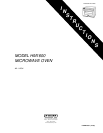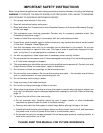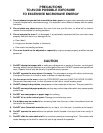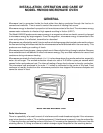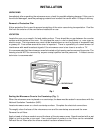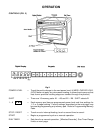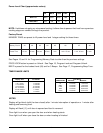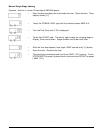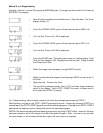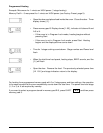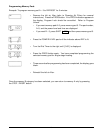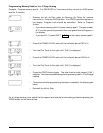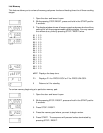
–5–
INSTALLATION, OPERATION AND CARE OF
MODEL HM1600 MICROWAVE OVEN
GENERAL
Microwave heat is generated inside the food rather than being conducted through the food as in
conventional methods. Time is used to control the amount of heating that occurs.
Microwave energy is absorbed in proportion to the moisture content of the food. The microwave energy
causes water molecules to vibrate at high speeds resulting in friction (HEAT).
The Model HM1600 produces microwave energy in a magnetron where an electric current is changed
to microwave energy by large magnets. From the magnetron, microwave energy is transmitted to the
oven cavity where it is reflected, transmitted or absorbed.
Microwaves are reflected by metal (interior walls and rotating waveguides located underneath or above
the floor and ceiling) which assures that the microwaves are well distributed within the oven cavity. This
produces even heating or cooking of foods.
Microwaves pass through paper, glass or plastic much like sunlight shining through a window. Because
these substances do not absorb or reflect microwave energy, they are ideal materials for use as food
containers during microwave heating.
Microwaves penetrate the food to about
3
/4 to 1
1
/2 inches deep where they excite molecules, especially
water, fat and sugar. The excited molecules vibrate at a rate of 2.45 billion cycles per second which
causes friction and produces heat. The internal heating of larger food volumes is done by conduction.
The microwave heat produced in the outer 1
1
/2 inches is conducted to the center of the food. Food
continues to heat by conduction after microwave production has stopped. Microwaves dissipate and
cannot be stored in food.
Model HM1600 Microwave Oven
Radio Interference
There is a possibility of a small amount of interference with weak broadcast signals if the microwave
oven is too close to a radio or TV or similar equipment. If interference is present, it may be reduced by:
1) Cleaning the door and sealing surface of the oven; 2) Increasing the separation of the oven from the
receiving device; 3) Using an antenna to obtain stronger signal reception for the receiving device.
PL-41348



